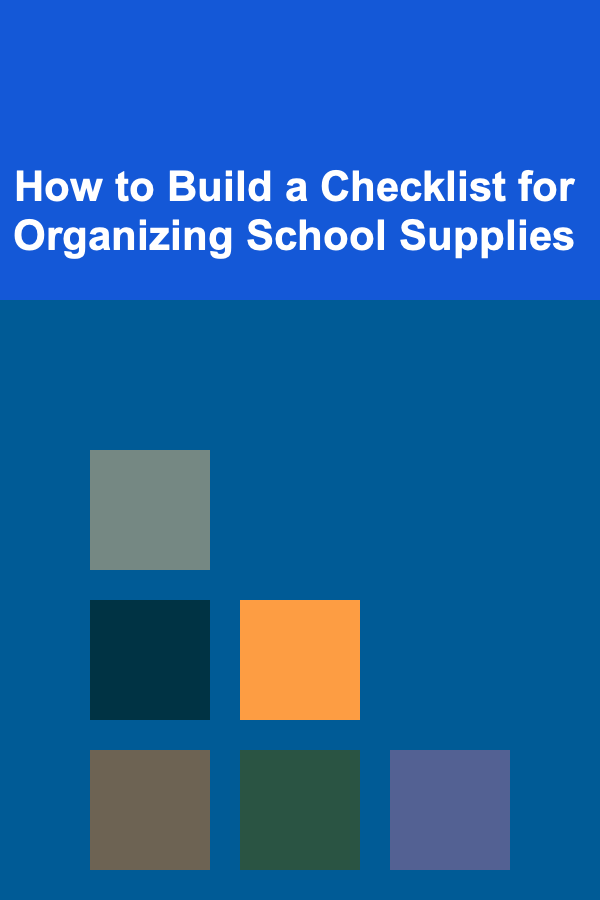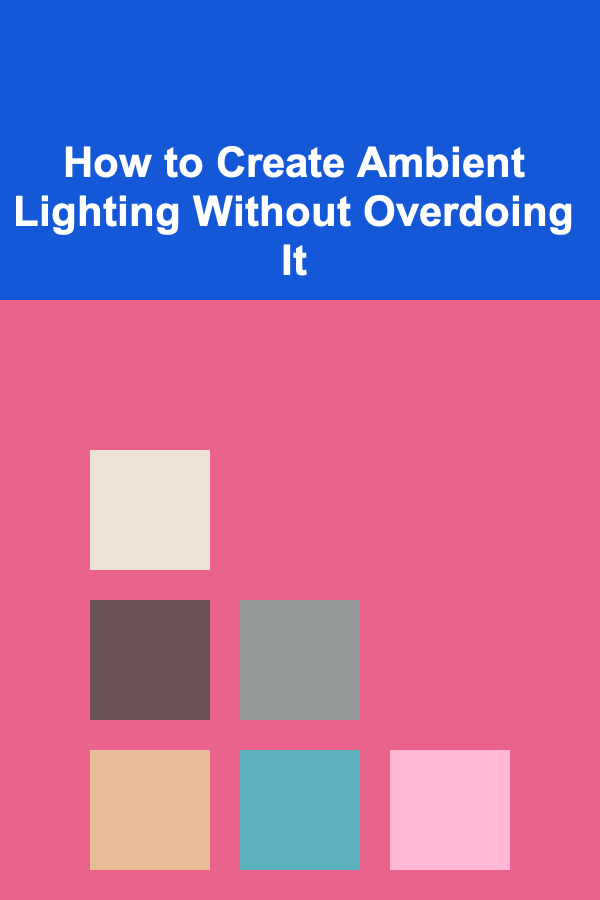
How to Use a Knitting Planner to Track Your Progress and Stay Motivated
ebook include PDF & Audio bundle (Micro Guide)
$12.99$10.99
Limited Time Offer! Order within the next:
Not available at this time

Knitting is a craft that offers a combination of creativity, mindfulness, and achievement. Whether you're knitting for personal use, as a hobby, or even as a small business venture, staying organized and motivated is essential. One of the most effective tools for knitting enthusiasts to enhance their crafting journey is a knitting planner. A knitting planner helps you stay on top of your projects, track your progress, and maintain motivation even through the most complex patterns.
In this article, we'll explore how you can use a knitting planner to track your progress, organize your thoughts, and stay motivated throughout your crafting projects. We'll cover the benefits of using a knitting planner, how to set it up, and different ways it can support you in achieving your knitting goals. Let's dive into how a knitting planner can help take your knitting journey to the next level.
The Benefits of Using a Knitting Planner
A knitting planner is more than just a notebook---it's a powerful tool that brings structure and organization to your crafting process. Below are some of the key benefits that a knitting planner can offer.
Stay Organized
A knitting planner allows you to organize your projects by keeping all the details in one place. From yarn choices and pattern notes to start and finish dates, having everything documented helps you stay on top of your projects. This is particularly useful if you are working on multiple projects at once, as you can easily track each one's progress.
- Example: If you're working on a sweater, a scarf, and a pair of socks, you can create a separate section for each project in your planner to track yarn, pattern, and any challenges or adjustments you've made.
Track Your Progress
One of the most satisfying aspects of knitting is seeing your work take shape over time. A knitting planner allows you to record the milestones and progress of your projects. Whether it's noting down the number of rows knitted, the completion of a pattern section, or the total number of stitches added, keeping track of your progress will give you a sense of accomplishment as you move forward.
- Example: You can create a habit tracker to mark off each day you knit or list specific milestones like "finish the sleeve" or "complete the ribbing section."
Set Achievable Goals
A knitting planner helps you break down big projects into smaller, achievable goals. Having clear goals helps prevent overwhelm and provides a sense of purpose in your work. Whether you're aiming to finish a project by a specific date or setting a goal to learn a new technique, your planner can keep you motivated by making those goals tangible and trackable.
- Example: If you have a big project like a blanket, you can set smaller goals, such as "knit 5 squares by the end of the week" or "finish one row each day."
Inspire Creativity
A knitting planner can be a place to jot down your creative ideas, experiment with color palettes, and explore new techniques. With sections dedicated to brainstorming, sketching, or writing down your inspirations, your planner can become a creative hub that fuels your next project. It can also serve as a reference for future projects, so you don't forget about any exciting ideas.
- Example: If you're inspired by a new yarn color, you can make notes on possible patterns or designs you want to try with it. This helps turn fleeting ideas into concrete plans.
Improve Skills and Technique
By tracking what you've knitted and the techniques you've used, you can monitor your improvement over time. This is especially helpful for those who are working on learning new skills, like lace knitting or cable work. As you note down techniques or challenges encountered in your projects, you'll be able to reflect on how far you've come and where you might want to focus on improving.
- Example: If you struggled with a certain stitch in a project, writing about it in your planner can remind you of areas to focus on next time or allow you to track the time it takes for you to master a new skill.
Setting Up Your Knitting Planner
The first step in using a knitting planner is to set it up in a way that makes sense for you. Everyone's knitting journey is different, so customization is key. Here's how you can start:
Choose the Right Planner
There are many types of knitting planners available, but the key is finding one that suits your style and preferences. Some planners come pre-designed with sections for patterns, project tracking, and inspiration. Others are blank notebooks or binders that you can customize yourself. If you prefer digital planning, there are apps and digital tools that can work as a knitting planner as well.
- Tip: If you enjoy tactile organization, a physical planner might be more satisfying. But if you're always on the go, a digital planner might be more accessible and flexible.
Create Project Pages
For each project, create a dedicated page in your planner. This page can include details such as:
- Pattern Name: Write the name of the pattern and any specific notes.
- Yarn Details: List the type, color, and quantity of yarn you are using.
- Needle Size: Note down the size of needles or hooks used for the project.
- Start and End Date: Write down when you begin and finish the project to keep track of your time investment.
- Project Goals: Set mini-goals, like completing a specific section of the pattern within a given timeframe.
- Example: For a sweater project, your project page might include information like "Pattern: Raglan Sweater" and "Yarn: 5 skeins of Merino Wool (Color: Ocean Blue). Needle Size: US 8." Add your goals such as "Finish back piece by Friday" and "Start sleeve by next week."
Track Progress and Milestones
Throughout the project, record the progress you've made. This can include:
- Daily or Weekly Tracking: Track how much you've knit each day or week.
- Milestones: Jot down when you complete key sections, like finishing a sleeve, completing the body, or starting the ribbing.
- Challenges or Insights: If you encounter any challenges (like tension issues or needing to substitute yarn), note them down so you can learn from the experience.
- Example: You could make a weekly habit tracker where you mark off each day you knit and add notes about any challenges, like "struggled with the lace pattern on row 12."
Incorporate Inspiration and Ideas
Set aside sections for inspiration or future project ideas. This could include things like:
- Patterns to Try: Keep a list of patterns you want to work on in the future.
- Yarn Wishlist: Write down yarns that inspire you, along with colors and textures.
- Creative Ideas: Jot down your ideas for color combinations, stitch patterns, or any personal designs you're considering.
- Example: You could have a section titled "Future Projects" where you write down things like "Cable Knit Scarf" and "Gradient Color Shawl."
Staying Motivated with Your Knitting Planner
Motivation can sometimes dip, especially during the longer phases of complex projects. A knitting planner can be an excellent tool for staying inspired and engaged with your work.
Visualize Your Progress
Looking back at how far you've come is a great way to stay motivated. Seeing how many milestones you've crossed, how many rows you've knitted, or how much yarn you've used can boost your sense of accomplishment. Include progress photos or notes about any challenges you've overcome to celebrate your success.
- Example: Attach photos of your project at various stages in your planner. Looking at a photo of a half-finished sweater can inspire you to finish it!
Set Realistic Deadlines
Deadlines can create a sense of urgency and keep you motivated. Whether it's for a gift, a seasonal project, or a personal goal, setting a deadline can help break down the overwhelming task of finishing a large project into manageable steps.
- Example: If you're knitting a scarf as a gift for a friend's birthday, set a deadline of "Finish scarf by 10th June" and work backward to break down the smaller tasks needed to reach that goal.
Celebrate Small Wins
Sometimes, just completing a few rows or finishing a section of a project is a huge accomplishment. Celebrate these moments by noting your achievements in your planner and taking time to reflect on your progress.
- Example: If you finish a challenging section, like a tricky cable pattern, write in your planner, "Completed cable section! Felt so accomplished after learning a new technique."
Stay Inspired by Creative Prompts
If you're stuck in a creative rut, a knitting planner can offer inspiration. You can add creative prompts or challenges that help you step outside your comfort zone. This can include trying a new technique, knitting with a new yarn, or attempting a more complex project.
- Example: Write down prompts like "Try knitting a shawl with lace" or "Learn to knit with double-pointed needles."
Conclusion
Using a knitting planner is more than just keeping track of your projects---it's a way to stay organized, motivated, and inspired throughout your knitting journey. Whether you're knitting for relaxation, skill development, or as a business venture, a planner helps you stay focused on your goals, celebrates small victories, and visualizes progress over time.
By setting up a well-organized planner, breaking down big projects into manageable steps, and keeping track of your progress, you can turn knitting into a more fulfilling and enjoyable craft. And most importantly, a knitting planner ensures that you'll stay motivated, even when the projects get tough, keeping you inspired to knit one stitch at a time. Happy knitting!

How to Build a Balanced Investment Portfolio for Beginners
Read More
How to Build a Checklist for Organizing School Supplies
Read More
How to Create Ambient Lighting Without Overdoing It
Read More
How to Stage a Bathroom for a Spa-Like Experience
Read More
How to Use AI Tools to Boost Your Earning Potential
Read More
How to Develop Blockchain Oracles for Real-World Data
Read MoreOther Products

How to Build a Balanced Investment Portfolio for Beginners
Read More
How to Build a Checklist for Organizing School Supplies
Read More
How to Create Ambient Lighting Without Overdoing It
Read More
How to Stage a Bathroom for a Spa-Like Experience
Read More
How to Use AI Tools to Boost Your Earning Potential
Read More